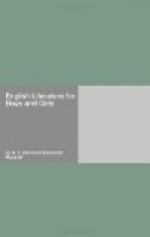“His men were rich,
and his country
Abounded well with corn and
cattle,
And of all kind other richness;
Mirth, solace, and eke blithness
Was in the land all commonly,
For ilk man blith was and
jolly.”
And here Barbour ends the first part of his poem. In the second part he goes on to tell us of how the Bruces carried war into Ireland, of how they overran Northumberland, and of how at length true peace was made. Then King Robert’s little son David, who was but five, was married to Joan, the seven-year-old sister of King Edward III. Thus, after war, came rest and ease to both countries.
But King Robert did not live long to enjoy his well-earned rest. He died, and all the land was filled with mourning and sorrow.
“‘All our defense,’ they said, ’alas! And he that all our comfort was, Our wit and all our governing, Is brought, alas, here to ending; . . . . . Alas! what shall we do or say? For in life while he lasted, aye By all our foes dred were we, And in many a far country Of our worship ran the renown, And that was all for his person.’”
Barbour ends his book by telling of how the Douglas set out to carry the heart of the Bruce to Palestine, and of how he fell fighting in Spain, and of how his dead body and the King’s heart were brought back to Scotland.
Barbour was born about six years after the battle of Bannockburn. As a boy he must have heard many stories of these stirring times from those who had taken part in them. He must have known many a woman who had lost husband or father in the great struggle. He may even have met King Robert himself. And as a boy he must have shared in the sorrow that fell upon the land when its hero died. He must have remembered, when he grew up, how the people mourned when the dead body of the Douglas and the heart of the gallant Bruce were brought home from Spain. But in spite of Barbour’s prayer to be kept from saying “ought but soothfast thing,” we must not take The Bruce too seriously. If King Robert was a true King he was also a true hero of romance. We must not take all The Bruce as serious history, but while allowing for the truth of much, we must also allow something for the poet’s worship of his hero, a hero, too, who lived so near the time in which he wrote. We must allow something for the feelings of a poet who so passionately loved the freedom for which that hero fought.
BOOKS TO READ
There is, so far as I know, no modernized version of The Bruce, but there are many books illustrative of the text. In this connection may be read Robert the Bruce (Children’s heroes Series), by Jeannie Lang; Chapters XXIV to XLIV. Scotland’s Story, by H. E. Marshall; The Lord of the Isles, by Sir Walter Scott; Castle Dangerous, by Sir Walter Scott; “The Heart of the Bruce” in Lays of the Scottish Cavaliers, by Aytoun. The most available version of The Bruce in old “Inglis,” edited by W. M. Mackenzie.




